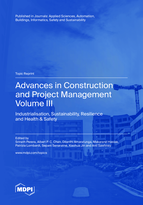Topic Menu
► Topic MenuTopic Editors






Advances in Construction and Project Management

A printed edition is available here.
Topic Information
Dear Colleagues,
The construction industry makes a significant contribution to the global economy. The output of the global construction industry was over USD 10.7 trillion in 2020; approximately 13% of the global gross domestic product. However, it is still the second least digitalised sector in the world, with productivity stagnating around 2%. Construction projects require the coordination of many specialists and suppliers of products, components, and sub-elements to construct a building or a structure. Therefore, effective management of construction projects is essential to ensure timely completion that meets quality standards within the prescribed scope and budget. Furthermore, assuring sustainability is crucial to reduce the impact of construction on the environment. The construction industry is also affected by globalisation and increasing susceptability to disasters highlighting the need for resilience in the industry, especially after global pandemics and natural disasters.
Digitalisation and industrialisation pave the way to solve or mitigate numerous issues in the construction industry by transforming business operations, improving productivity and safety, ensuring quality and compliance to standards, increasing sustainability, among others. It is imperative for project managers and other construction stakeholders to be digitally oriented.
This article collection in construction and project management aims to explore advances in digital, sustainable, and industrialised construction solutions for prevalent issues in construction and project management. It will also investigate the impacts of globalisation and the need for resilience in the construction industry. Potential research topics include, but are not limited to, applications of blockchain technology, Building Information Modelling (BIM), the Internet of Things (IoT), Design for Manufacture and Assembly (DfMA), industrialised construction, circular economy, sustainable construction, building resilience and safety in the construction industry, and impacts of globalisation.
Prof. Dr. Srinath Perera
Prof. Dr. Albert P. C. Chan
Prof. Dr. Dilanthi Amaratunga
Prof. Dr. Makarand Hastak
Prof. Dr. Patrizia Lombardi
Dr. Sepani Senaratne
Dr. Xiaohua Jin
Dr. Anil Sawhney
Topic Editors
Keywords
Construction project management – construction management, productivity and scheduling; risk management; lean construction; stakeholder management; procurement; quality management; Infrastructure management, profitability and International construction, globalisation
Digitalisation – Building Information Modeling (BIM); blockchain and smart contracts; Artificial Intelligence (AI), Machine Learning (ML) and Deep Learning (DL); barriers and challenges; Big data and data analytics; cloud computing; enterprise systems; Virtual Reality (VR), Augmented Reality (AR), and Digital twin; multicriteria spatial decision support systems (GIS-based)
Industrialisation – automation; robotics; offsite construction; Industrialisation 4.0; 3D printing; drones; Internet of Things (IoT) and sensors; smart cities; supply chain management; Design for Manufacture and Assembly (DfMA)
Sustainability – waste management; life cycle carbon management; environment sustainability; social sustainability; circular economy; energy management; green buildings; climate change
Resilience – disaster management, building resilience, improving social, environmental and economic resilience
Health & Safety – occupational health and safety; environmental hazards; toxic waste; risk assessment (including hazard prevention, control and management); human factors and machine interaction; mental health; disability management
Participating Journals
| Journal Name | Impact Factor | CiteScore | Launched Year | First Decision (median) | APC |
|---|---|---|---|---|---|

Applied Sciences
|
2.7 | 4.5 | 2011 | 16.9 Days | CHF 2400 |

Automation
|
- | - | 2020 | 26.3 Days | CHF 1000 |

Buildings
|
3.8 | 3.1 | 2011 | 14.6 Days | CHF 2600 |

Informatics
|
3.1 | 4.8 | 2014 | 30.3 Days | CHF 1800 |

Safety
|
1.9 | 3.3 | 2015 | 29.6 Days | CHF 1800 |

Sustainability
|
3.9 | 5.8 | 2009 | 18.8 Days | CHF 2400 |

MDPI Topics is cooperating with Preprints.org and has built a direct connection between MDPI journals and Preprints.org. Authors are encouraged to enjoy the benefits by posting a preprint at Preprints.org prior to publication:
- Immediately share your ideas ahead of publication and establish your research priority;
- Protect your idea from being stolen with this time-stamped preprint article;
- Enhance the exposure and impact of your research;
- Receive feedback from your peers in advance;
- Have it indexed in Web of Science (Preprint Citation Index), Google Scholar, Crossref, SHARE, PrePubMed, Scilit and Europe PMC.



